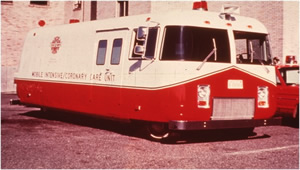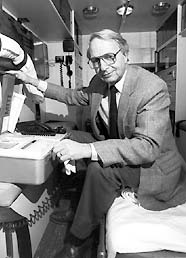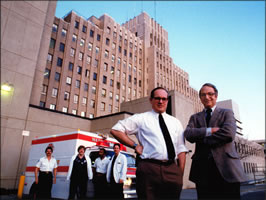 In the late 1960’s, a group of Seattle physicians, led by Dr. Leonard A. Cobb, a Cardiologist at Harborview Medical Center, recognized the potential for saving the lives of heart attack victims in the pre-hospital setting. They also realized that in order to accomplish this, it would be necessary to train and equip a group of technicians to perform certain medical procedures in the field.
In the late 1960’s, a group of Seattle physicians, led by Dr. Leonard A. Cobb, a Cardiologist at Harborview Medical Center, recognized the potential for saving the lives of heart attack victims in the pre-hospital setting. They also realized that in order to accomplish this, it would be necessary to train and equip a group of technicians to perform certain medical procedures in the field.
It was decided that the most appropriate agency for this task was the Seattle Fire Department, an organization already dedicated to rapid response in emergency situations. Gordon F. Vickery, then Chief of the Seattle Fire Department, was already in the process of improving first-aid training for the firefighters and procuring more efficient aid vehicles.
The physicians, many of whom had wartime medical experience, recognized that motivated people with a basic education could be trained to perform sophisticated, physician-level medical procedures with proficiency. Chief Vickery recognized that this advanced emergency medical service was a logical extension of services the Fire Department already provided. Thus, from this amalgamation of interests, Seattle Medic One was born.
In late 1969, the first class of 15 Seattle Fire Department personnel began a training course, designed specifically to provide pre-hospital treatment of patients with cardiac complaints. The students learned the essentials of coronary care, including twelve lead EKG interpretation, rhythm recognition, drug therapy, intracardiac injection, IV placement, endotracheal intubation, defibrillator use, and patient monitoring. The course included 200 hours of classroom instruction, and about 700 hours of internship in the Harborview Medical Center operating room and emergency room supervised by the physicians in those arenas.
 March 7, 1970 marked the first day of operation for Seattle Fire Department paramedics. At that time, Washington State law required that they be accompanied by a physician on every emergency call.
March 7, 1970 marked the first day of operation for Seattle Fire Department paramedics. At that time, Washington State law required that they be accompanied by a physician on every emergency call.
Shortly after its inception, Medic One began to produce positive results; patients who were clinically dead on the paramedics’ arrival were successfully resuscitated at the scene, hospitalized, and eventually released to return to normal lives. Countless other patients were stabilized at the scene with intravenous drug therapy and other advanced procedures, and in many cases, owed their lives to this special care.
Because of the growing number of successes, which produced increased citizen demand, it soon became apparent that advanced pre-hospital care in other critical situations could make a significant difference in the survival and quality of recovery of those patients. The result of this was an expanded role for paramedics that required a broadening of training to include advanced care for trauma, recognizing acute illnesses, poisonings, allergies, neurological problems, literally all facets of out-of-hospital emergency care.
By 1972, the Paramedic Training Program had evolved into the entity that exists now; physician-taught didactic training, extensive patient contact on the Seattle Medic One vehicles and in the Harborview Medical Center Emergency Room, and an intensive field evaluation process that includes assessments by both senior paramedics and physicians.
Although changes in Washington State law in 1972 eliminated the need for direct physician supervision of paramedics in the field, physician input has remained an important part of the training program. The final phase of field internship (the physician evaluations) provides paramedic students the opportunity to interact with physicians in the field setting, and gain valuable insight regarding pathophysiology, differential diagnosis, or therapeutic possibilities.
In 1975, the Medic One Program physically expanded to include the training of paramedics from other emergency care provider groups within King County. With the certification of the most recent class in 2017, 702 paramedics have graduated from The University of Washington School of Medicine Paramedic Training Program. Upon completion of the program, paramedic students are certified as Mobile Intensive Care Paramedics by the Washington State Department of Health.
Throughout the history of the Medic One Program, program administrators have recognized the need for rapid intervention by personnel who could initiate basic life support procedures in the event of cardiac or respiratory arrest. This awareness has spawned a number of innovative concepts within Seattle and King County, one of which is the layered response system which sends the nearest Fire Department Engine Company to medic responses if an Aid Car, Ambulance or Medic Unit is not in the immediate vicinity. The average response time for the first arriving Unit to such an aid call is about 3 to 4 minutes - one of the fastest average times in the Nation. The residential engine companies carry automatic defibrillators which are used to restore the heartbeat in certain patients in cardiac arrest. Through an innovative Citizen CPR program, over 50% of the citizens of Greater King County have been trained to perform CPR. In addition, Fire Department dispatchers give CPR instructions over the phone to bystanders who are willing to attempt the procedure.
The Paramedic Training Program continues to respond to the changing medical practices and technology. It also continues to maintain close ties with the Seattle Fire Department’s Medic One program and follows their field studies on subjects such as quick defibrillation, drug efficacy, and trauma management. The information obtained by these studies leads to adjustments in the operation of both Medic One and Paramedic Training.
After the expansion of Medic One to include all out-of-hospital emergencies, the time required to teach the larger curriculum, as well, has increased. The Paramedic Training Program is now approximately 2500 hours in length, and is completed in a period of ten months. Exact course duration varies, depending on class size and student readiness. Harborview Medical Center, an affiliated teaching hospital of The University of Washington School of Medicine, houses the Training Program office, classrooms, a library, and student study areas.
Harborview Medical Center (the only Level 1 Trauma Center in the region) houses an impressive variety of medical facilities and services. The leading academic Trauma and Acute Care Surgery department is located at HMC. Additional resources include an emergency department with a daily census of 180 patients, a 24 bed Northwest Regional Burn Center, a 24 bed Trauma/Surgical ICU (TSICU), 30 bed Neuro ICU, and 17 bed Medical/Cardiac ICU (MCICU). Two of the Seattle Fire Department Mobile Intensive/Coronary Care Units (M1 and M10) are based at Harborview Medical Center, which is accredited by The Joint Commission. Accreditation is renewed every five years with the next site visit set for late 2018.
The majority of Paramedic Training activities are accomplished at Harborview Medical Center. All didactic classes, emergency room and coronary care unit study, and nearly all teaching ward rounds take place at this facility. For some specialty aspects of training, paramedic students are assigned to rotations in other University of Washington School of Medicine affiliated teaching hospitals in Seattle. They are assigned to the Labor and Delivery Suite at University Hospital for obstetrical experience, and to Seattle Children’s Hospital Emergency and Operating rooms for experience in performing pediatric intubations and evaluating emergency pediatric patients.
The Paramedic Training Program remains closely tied to the Seattle Fire Department Medic One Program. This allows the paramedic students to accrue field experience by accompanying certified paramedics on medical calls throughout the entire educational experience. Other Seattle Fire Department facilities are also used for specified training sessions. These include drills and practical experience in triage and vehicular and building extrication.
The training program has long demanded that a paramedic student achieve parity with a well trained physician in the exhibition of certain technical feats; i.e., tracheal intubation, IV placement, defibrillation, resuscitation. In addition, the training program specifically adjusts to new medical information and new equipment used in the field. The training requirements, existant since the inception of the program, has not required much modification save the welcomed addition of the management of airway distress in the pediatric patient. This legacy lives on with the paramedics serving our community, and the commitment to the highest quality care for our patients.

